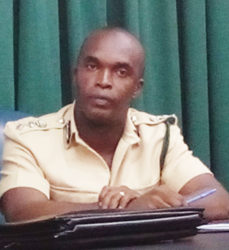According to Joint Services attorney Selwyn Pieters, it was not Deputy Director Gladwin Samuels who ordered the door to Capital A closed on March 3 when a fire killed 17 prisoners, but a subordinate officer, who gave the instruction after prisoners began rioting.
Pieters related this information during a break in yesterday’s proceedings, at which time he and Samuels engaged the media. The officer he referred to had given in-camera testimony at the hearing on Tuesday, during which footage was reportedly played, showing clearly by whom the order was passed, and who locked the door. The instruction was reportedly passed after prisoners began rioting, rushing the door with improvised weapons.
In Samuels’ evidence yesterday—as had been repeatedly stated by Pieters prior to Samuels’ testimony—he maintained that when he arrived at the prison, the search had already been underway. Samuels’ evidence is that when he arrived at the Camp Street prison, the door to the Capital A division had already been closed.

But the testimonies of numerous witnesses placed Samuels on the scene before the search began. Samuels has maintained, however, that this was not the case, and that records exist to prove such. Prisoners had also claimed that they either heard, or both witnessed and heard Samuels give an order for the door to the division to be shut as prisoners exited. One inmate who had been in Capital A at the time, testified that he was on his way out of the division when the door was closed in his face.
Under cross-examination by attorney Dexter Todd, it was put to Samuels that there was a voice heard on tape ordering that the prisoners be left to burn, and that the voice and words came from Samuels. He denied the accusation, stating that at no time did he utter those words, nor did he hear anyone else say them.
When asked during the media question and answer why prisoners seemed to have a problem with him judging from the allegations being levelled, the Senior Superintendent stated that in his 15 years in the system, he has interrupted what he referred to as a “multi-million dollar” trade of contraband, having removed pounds of marijuana during raids, and thousands of packs of cigarettes.
“If you do the mathematics based on the re-sale value in prison, those prisoners would have lost significant amounts of cash, and those are the reasons why they would not like someone like me around,” he said, having noted that many prisoners use the money they earn from selling illegal items in prison to maintain their families and pay fees attached to their imprisonment.
According to the Senior Superintendent’s testimony on Tuesday, when he first observed the second fire in Capital A (after the first had been extinguished using fire extinguishers), he was on the corridor to the division, having just evacuated the Capital B dorm.
An instruction had just been passed by him to have the door to the dorm closed, declaring it “sanitized” and that anyone found there would be deemed “illegal.”
After spotting the flames, he proceeded into the prison yard, where he passed an order for the door to the A division to be opened, but it was related that the officers were having some difficulty doing such.
He said that he next passed an order for the door to Capital B to be reopened, and instructed that the inmates remaining in A should exit through the hole they had created in the wall. He said he heard this order being passed to the inmates. When the door was re-opened, he said he observed some amount of smoke in the room, but stated that no officers had actually entered the room as no instruction had been given by him for them to do so.
Having stated that given the configuration of the building they were not able to engage the fire from the exterior of the dorm, and having related in testimony on Tuesday that he noticed prisoners were not exiting through Capital B via the hole, Todd enquired as to why officers did not check to see whether the hole was clear enough to facilitate exit.
Samuels replied that it was because that order was not passed by him based on his assessment of the situation, which revealed that there was low visibility in the room from the smoke. Todd then asked whether it occurred to him at the time that perhaps the prisoners were trapped and could not move, to which he said the fire he observed was at the front of the building, and from his position, he could not see if the area of the hole was also covered.
When Todd made another move to question why officers were not sent to check the hole for themselves, an objection was raised by Joint Services attorney Eusi Anderson, who interjected to state that testimonies provided by Fire Service officers last week revealed that the source of the largest fire was at that hole. While Samuels in no way indicated that he had knowledge of that fact during his testimony, the interruption from Anderson succeeded in diverting the line of questioning.
Although Samuels testified that he was made aware of the hole in the wall between the two divisions not long after he entered the prison, a first responder from the Fire Service had testified that firefighters had not been aware that there was another entry to Capital A through the hole until after the fire was extinguished and they entered the dorm.
Samuels’ testimony will continue today, beginning with an in-camera hearing this morning where he will be examined on footage admitted into evidence on Tuesday. He is also to be re-examined by Pieters.




